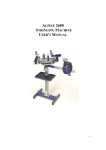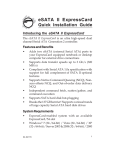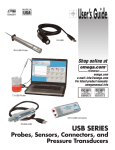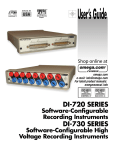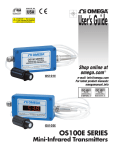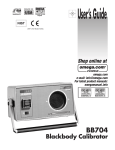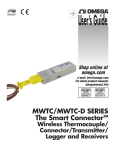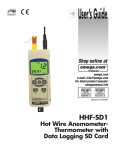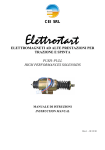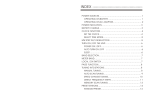Download Long Range Wireless System - HPWS Series
Transcript
MADE IN ® User’s Guide Shop online at omega.com e-mail: [email protected] For latest product manuals: omegamanual.info HPWS SERIES Long Range Wireless System OMEGAnet ® Online Service omega.com Internet e-mail [email protected] Servicing North America: U.S.A.: ISO 9001 Certified Canada: Omega Engineering, Inc., One Omega Drive, P.O. Box 4047 Stamford, CT 06907-0047 USA Toll Free: 1-800-826-6342 TEL: (203) 359-1660 FAX: (203) 359-7700 e-mail: [email protected] 976 Bergar Laval (Quebec), H7L 5A1 Canada Toll-Free: 1-800-826-6342 FAX: (514) 856-6886 TEL: (514) 856-6928 e-mail: [email protected] For immediate technical or application assistance: U.S.A. and Canada: Sales Service: 1-800-826-6342/1-800-TC-OMEGA® Customer Service: 1-800-622-2378/1-800-622-BEST® Engineering Service: 1-800-872-9436/1-800-USA-WHEN® Mexico/ Latin America: En Español: 001 (203) 359-7803 [email protected] FAX: 001 (203) 359-7807 e-mail: [email protected] Servicing Europe: Benelux: Managed by the United Kingdom Office Toll-Free: 0800 099 3344 TEL: +31 20 347 21 21 FAX: +31 20 643 46 43 e-mail: [email protected] Czech Republic: Frystatska 184 733 01 Karviná, Czech Republic Toll-Free: 0800-1-66342 FAX: +420-59-6311114 France: TEL: +420-59-6311899 e-mail: [email protected] Managed by the United Kingdom Office Toll-Free: 0800 466 342 TEL: +33 (0) 161 37 29 00 FAX: +33 (0) 130 57 54 27 e-mail: [email protected] Germany/Austria: Daimlerstrasse 26 D-75392 Deckenpfronn, Germany Toll-Free: 0800 6397678 FAX: +49 (0) 7056 9398-29 United Kingdom: ISO 9001 Certified TEL: +49 (0) 7056 9398-0 e-mail: [email protected] OMEGA Engineering Ltd. One Omega Drive, River Bend Technology Centre, Northbank Irlam, Manchester M44 5BD United Kingdom Toll-Free: 0800-488-488 TEL: +44 (0) 161 777-6611 FAX: +44 (0) 161 777-6622 e-mail: [email protected] It is the policy of OMEGA Engineering, Inc. to comply with all worldwide safety and EMC/EMI regulations that apply. OMEGA is constantly pursuing certification of its products to the European New Approach Directives. OMEGA will add the CE mark to every appropriate device upon certification. The information contained in this document is believed to be correct, but OMEGA accepts no liability for any errors it contains, and reserves the right to alter specifications without notice. WARNING: These products are not designed for use in, and should not be used for, human applications. HPWS SERIES Long Range Wireless System Table of Contents Section Page Section 1 Introduction ................................................................................... 1-1 1.1 Precautions .......................................................................................... 1-1 1.2 Product Labeling ................................................................................ 1-2 1.3 FCC ........................................................................................................ 1-3 1.4 CE Marking .......................................................................................... 1-3 1.5 General Description and System Components ............................... 1-3 Section 2 Hardware ....................................................................................... 2-1 2.1 Package Inspection .............................................................................. 2-1 2.2 Included Items .................................................................................... 2-1 2.3 Accessories ........................................................................................... 2-1 Section 3 Transmitter Operation ................................................................. 3-1 3.1 Figures .................................................................................................. 3-1 3.2 Open Enclosure.................................................................................... 3-1 3.3 Initial Wiring ........................................................................................ 3-2 3.3.1 Pass Wires Into Enclosure ......................................................... 3-2 3.3.2 Connect Signal Wires To Barrier Strip ..................................... 3-2 3.3.3 Connect AC Power ..................................................................... 3-3 3.3.4 Connect Battery .......................................................................... 3-4 3.4 Connect External Antenna ................................................................ 3-5 Section 4 Receiver Operation ....................................................................... 4-1 4.1 Switch Operation................................................................................. 4-1 4.2 Initial Setup .......................................................................................... 4-1 4.2 1 Open Transmitter Enclosure ..................................................... 4-1 4.2.2 Pass Wires Into Enclosure ......................................................... 4-1 4.2.3 Connect Signal Wires To Barrier Strip ..................................... 4-2 4.2.4 Connect AC Power ..................................................................... 4-3 4.4 Connect External Antenna .................................................................4-5 Section 5 System Operation.......................................................................... 5-1 5.1 Introduction.......................................................................................... 5-1 5.2 RF Communication Basics ................................................................. 5-1 5.3 Basic System Overview ...................................................................... 5-1 5.4 Transmitter/Receiver Operation....................................................... 5-1 5.4.1 Button Operation ....................................................................... 5-1 5.5 Environment/Operating Conditions ............................................... 5-2 5.5.1 Environment................................................................................ 5-2 5.5.2 Operating Conditions ................................................................ 5-2 5.6 Determining and Maximizing Range ............................................... 5-3 5.7 Mounting the HPWS Unit.................................................................. 5-3 5.8 Installing the Antenna ........................................................................ 5-4 i HPWS SERIES Long Range Wireless System Table of Contents continued Section Page Section 6 Advanced Features ....................................................................... 6-1 6.1 Address Codes .................................................................................... 6-1 6.2 Multiple Transmitters ........................................................................ 6-2 6.3 Normally Open vs. Normally Closed Outputs ............................... 6-3 6.4 Status Alerts ......................................................................................... 6-5 6.4.1 Location of the Status Alert Dipswitches on Transmitter..... 6-5 6.4.1 Location of the Status Alert Dipswitches on Receiver .......... 6-6 6.5 Low Battery Alert (Receiver Only).................................................... 6-7 6.6 Auto Restore (Transmitter Only)....................................................... 6-7 6.7 Replacing the Battery .......................................................................... 6-8 Section 7 Specifications General ................................................................. 7-1 Section 8 Approvals, Regulatory Compliance ......................................... 8-1 8.1 FCC (Domestic Use) .................................................................................. 8-1 8.2 Internation Usage & CE Marking............................................................ 8-1 8.3 Declaration of Conformity ...................................................................... 8-1 ii HPWS SERIES Long Range Wireless System List of Figures Section 1.2 1.2 1.2 1.2 1.2 1.2 1.3 1-3 3.1 3.1 3.3 3.3 3.3 3.3 4.2 4.2 Figure 1-1 1-2 1-3 1-4 1-5 1-6 1-7 1-8 3-1 3-2 3-3 3-4 3-5 3-6 4-1 4-2 4.2 4-3 4.2 5.6 5.6 6.1 6.2 6.3 6.3 6.4 6.4 6.7 4-4 5-1 5-2 6-1 6-2 6-3 6-4 6-5 6-6 6-7 Description . . . . . . . . . . . . . . . . . . . . . . . . . . . . . . . . . Page HPWS-TX Transmitter/Receiver Label . . . . . . . . . . 1-2 HPWS Battery Backup Caution Label . . . . . . . . . . . . 1-3 Power Supply DC Terminal Label . . . . . . . . . . . . . . . 1-3 Power Supply AC Terminal Label . . . . . . . . . . . . . . .1-3 Transmitter Barrier Strip Label . . . . . . . . . . . . . . . . . . 1-3 Receiver Barrier Strip Label . . . . . . . . . . . . . . . . . . . . 1-3 System Components . . . . . . . . . . . . . . . . . . . . . . . . . . 1-4 General Dimensions . . . . . . . . . . . . . . . . . . . . . . . . . . . 1-4 Open Enclosure (Model HPWS-TX) . . . . . . . . . . . . . . 3-1 Transmitter Wiring Diagram - (Model HPWS-TX) . . . 3-1 HPWS Enclosure Connections . . . . . . . . . . . . . . . . . . 3-2 Barrier Strip Connections (Model HPWS-TX) . . . . . 3-3 Grounding Bus Bar Connection . . . . . . . . . . . . . . . . . 3-3 HPWS Power Supply . . . . . . . . . . . . . . . . . . . . . . . . . . 3-4 HPWS Enclosure Connections . . . . . . . . . . . . . . . . . . 4-1 Transmitter Wiring Diagram (Model HPWS-REC and HPWS-REC-BATT) . . . . . . 4-2 Grounding Bus Bar Connection (Model HPWS-REC) . . . . . . . . . . . . . . . . . . . . . . . . . . . 4-3 HPWS Power Supply . . . . . . . . . . . . . . . . . . . . . . . . . . 4-4 Basic System Overview . . . . . . . . . . . . . . . . . . . . . . . . 5-1 Fresnel Zone . . . . . . . . . . . . . . . . . . . . . . . . . . . . . . . . . 5-3 Address Codes On HPWS Receiver . . . . . . . . . . . . . 6-1 Multiple Transmitters . . . . . . . . . . . . . . . . . . . . . . . . . .6-2 Transmitter Dip Switches . . . . . . . . . . . . . . . . . . . . . . .6-3 Signal Input Block (Model HPWS-REC) . . . . . . . . . . .6-4 Transmitter Option Switches (Model HPWS-TX) . . . 6-5 Receiver Status Alert Dipswitches . . . . . . . . . . . . . . . 6-6 Battery . . . . . . . . . . . . . . . . . . . . . . . . . . . . . . . . . . . . . . . 6-8 iii HPWS SERIES Long Range Wireless System NOTES: iv Introduction 1 Section 1 - Introduction Please read this manual completely before installing and operating your wireless transmitter and receiver system. It is important to read and follow all notes, cautions, warnings, and safety precautions before operating this device. “Device” referrers to your transmitter or receiver unit. 1.1 Precautions WARNING: Equipment sold by OMEGA Engineering, Inc. is not intended to be used, nor shall it be used: 1) As a "Basic Component" under 10 CFR21 (NRC), used in or with any nuclear installation or activity; or 2) In medical applications or used on humans. Should this equipment be used in or with any nuclear installation or activity, medical application, used on humans, or misused in any way, purchaser will indemnify OMEGA and hold OMEGA harmless from any liability or damage whatsoever arising out of the use of the equipment in such a manner. WARNING: This device is subject to FCC regulations under 47 CFR Part 95 and may only be used within the territorial limits of the United States. Please refer to FCC regulation 47 CFR Part 95.405 for a definitive list. Transmitters contained in this device have limited transmitter power and limited range. A receiver cannot respond to more than one transmitted signal at a time and may be blocked by radio signals that occur on or near the operating frequencies, regardless of code settings. Changes or modifications to this device may void FCC compliance. Infrequently used radio links should be tested regularly to protect against undetected interference or fault. This device should not be used in life safety or medical appplications. The FCC allows high powered and/or unlicensed transmissions around the frequency used by this device. These transmissions may interfere or prevent normal operation of the device. This device should not be used near equipment which uses the medical device radio communication service or wireless medical telemetry device service or wireless medical telemetry device service, such as but not limited to, implanted medical devices or electrocardiogram equipment. This product may not be used aboard an in-flight aircraft. This device is marked with the international caution symbol. It is important to read this manual before installing or commissioning this device as it contains important information relating to Safety and EMC (Electromagnetic Compatibility). 1-1 1 Introduction EMC Considerations • Whenever EMC is an issue, always use shielded cables. • Never run signal and power wires in the same conduit. • Use signal wire connections with twisted-pair cables. • Install Ferrite Bead(s) on signal wires close to the instrument if EMC problems persist. Failure to follow all instructions and warnings may result in injury! Other Precautions • This device is not designed for use in any medical or nuclear applications. • Do not operate this device in flammable or explosive environments. • Never operate with a power source other than the one recommended in this manual or listed on product labels. • Do not operate this device outside of the recommended use outlined in this manual. • Never use your HPWS transmitter as a portable device. Your unit has been designed to be operated in a permanent installation only. • Never install and/or operate your HPWS transmitter closer than 20 cm to nearby persons. 1.2 Product Labeling ® HPWS SERIES LONG RANGE WIRELESS SYSTEM 27.255 MHz TRANSMITTER RECEIVER ! ADDRESS: OMEGA ENGINEERING, INC. Stamford, CT 06907 ® 800-TC-OMEGA Figure 1-1. HPWS-TX Transmitter/Receiver Label NOTE: The main product label contains two white boxed areas that can be used as write-on surfaces for your convenience. The bottom box is intended to reference the address code of the transmitter or receiver. The top box is ‘free-space’ and can be used for designating where the unit is located or for other user-desired purposes. 1-2 Introduction 1 CAUTION: UNIT IS POWERED WHENEVER BATTERY IS CONNECTED! TO COMPLETELY POWER DOWN, DISCONNECT AC POWER AND BATTERY CONNECTORS. Figure 1-2. HPWS Battery Backup Caution Label + DC - + BAT - Figure 1-3. Power Supply DC Terminal Label AC N G L GND CH4 COM CH4 CH3 GND CH2 GND CH1 GND N/A N/A Figure 1-4. Power Supply AC Terminal Label CH3 COM CH2 COM CH1 COM STAT BATT Figure 1-5. Transmitter Barrier Strip Label Figure 1-6. Receiver Barrier Strip Label 1.3 FCC This product complies with Part 95 of the FCC rules. Normal operation as intended by this manual does not require a radio license. 1.4 CE Marking It is the policy of OMEGA to comply with all worldwide safety and EMI/EMC regulations that apply. OMEGA is constantly pursuing certification of its products to the European New Approach Directives. OMEGA will add the CE mark to every appropriate device upon certification. Since the HPWS is not intended for use in Europe, CE status has not been verified at this time. 1.5 General Description and System Components The HPWS Series long range wireless system allows users to remotely monitor the status of up to four discrete switches such as level, flow, or other contact switches. The HPWS-TX transmitters are capable of sending signals to their corresponding HPWS-REC receivers up to a distance of 8 miles. The HPWS series wireless system is programmed to work with discrete input, SPST switches; the HPWS-REC unit can monitor up to four switches located on one to four HPWS-TX transmitters. 1-3 1 Introduction HPWS-TX TRANSMITTER HPWS-REC/ HPWS-REC-BATT RECEIVER Figure 1-7. System Components 343 (13.50) 272 (10.71) 272 (10.71) 51 (2.00) 203 (8.00) 44 (1.72) 216 (8.51) 298 (11.74) 325 (12.80) 176 (6.94) 53 (2.07) 5 (0.20) DIMENSIONS mm (in) Figure 1-8. General Dimensions 1-4 Hardware 2 Section 2 - Hardware It is important that you read this manual completely and follow all safety precautions before operating this instrument 2.1 Package Inspection Remove the packing list and verify that you have received all your equipment. If you have any questions about the shipment, please call our Customer Service Department at 1-800-622-2378 or 203-359-1660. We can also be reached on the Internet at omega.com, and by e-mail at [email protected]. When you receive the shipment, inspect the container and equipment for any signs of damage. Note any evidence of rough handling in transit. Immediately report any damage to the shipping agent. NOTE: The carrier will not honor any damage claims unless all shipping material is saved for inspection. After examining and removing contents, save packing material and carton in the event reshipment is necessary. 2.2 Included Items 2.2.1 The following items are supplied in the box: With the HPWS-TX Transmitter • 1 Transmitter • 3 foot Antenna with mounting kit and 18’ of RG-58 Cable (may ship separately) • User’s Manual • 2 AC Cable Holders With the HPWS-REC or HPWS-REC-BATT Receiver • 1 Receiver Device (with battery backup for HPWS-REC-BATT) • 3 foot Antenna with mounting kit and 18' of RG-58 cable (may ship separately • 2 AC Cable Holders • User’s Manual 2.3. Accessories The HPWS is offered with the following accessories/replacement parts: • OM-AMPOLEMNT10: Pole mount kit for enclosure includes: • 14 gauge galvannealed steel • 48" stainless steel pole clamp • #10-32 stainless steel screws • Washers • Lock nuts Note: The pole mount kit mounts only the enclosure. • HPWS-BATT: Replacement backup battery (12V, 5 Amp-hour) • HPWS-ANT: Replacement antenna 2-1 3 Transmitter Operation Section 3 - Transmitter Operation 3.1 Figures AC/DC POWER SUPPLY GROUND BUS BAR TRANSMITTER CIRCUIT BOARD BARRIER STRIP BACKUP BATTERY Figure 3-1. Open Enclosure (Model HPWS-TX) AC/DC POWER SUPPLY G N - GND - + DC BAT +12V DC L AC + GROUND BUS BAR NOT IN USE NOT IN USE GND + - CH 1 GND CH 2 GND GND CH 1 CH 2 GND GND GND GND CH 3 CH 4 CH 3 12V BACKUP BATTERY CH 4 BARRIER STRIP TRANSMITTER CIRCUIT BOARD Figure 3-2. Transmitter Wiring Diagram - (Model HPWS-TX) 3.2 Open Enclosure Open transmitter enclosure by unscrewing the four (4) screws on the lid. 3-1 Transmitter Operation 3 3.3 Initial Wiring 3.3.1 Pass Wires into Enclosure Pass the signal and AC power wires into the enclosure via the cable glands. Figure 3-3, below shows the recommended use of the included cable glands. Signal Wires | Antenna | AC Power Cable Figure 3-3. HPWS Enclosure Connections The cable glands provide a watertight seal that will protect the enclosure in case of normal rain, ice, or snow when the cables are installed correctly. In order for the enclosure to be weatherproof, it is necessary to tighten the cap of the strain relief of the cable gland to ensure a proper seal. If space remains in the cable strain relief after the cap is tightened, reinsert wires using a cable fitting to eliminate any path for moisture. NOTE: The HPWS has been tested to NEMA 4X (IP66) standards, but has not been tested for use in extreme rain, sleet, snow, wind, or other abnormal weather conditions.) 3.3.2 Connect Signal Wires To Barrier Strip Connect Signal wires from up to four (4) switches to the barrier strip as shown in wiring diagram below. If less than four switches are being used, do not connect any wires to that channel on the terminal block. 3-2 3 Transmitter Operation BATT STATUS COM BAT AC COM + + N L - GROUND BUS BAR G CH 1 - CH 2 DC COM CH 3 COM CH 2 CH 3 CH 4 N/C COM N/C N/O COM N/C N/O COM N/C CH 1 N/O COM N/O STATUS LOW BATT GND +12V DC POWER SUPPLY BARRIER STRIP CH 4 + RECEIVER CIRCUIT BOARD - 12V BATTERY BACKUP (HPWS-REC-BATT ONLY) Figure 3-4. Barrrier Strip Connections (Model HPWS-TX) 3.3.3 Connect AC Power CAUTION: Only connect the HPWS unit to an AC power source of 115VAC, 60Hz, 0.95Amp, or 230VAC, 50Hz, 0.6Amp. The power supply is not designed to work with other power modes. Ensure the power switch on the power supply is selected to OFF before proceeding and that power is completely disconnected from the unit. Connect the AC Ground wire to the grounding bus bar located on the steel sub panel. Ensure the ground wire is securely locked to the grounding bar using the included screw. Figure 3-5. Grounding Bus Bar Connection 3-3 Then, connect the AC Line wire to the terminal labeled L, and Neutral to N. Transmitter Operation 3 Figure 3-6. HPWS Power Supply 3.3.4 Connect Battery WARNING: Sealed Lead Acid (SLA) batteries may get hot, explode or ignite and cause serious injury if exposed to abusive conditions. Be sure to follow the safety warnings listed below: Your HPWS operates with one 12V, 5Amp-Hour SLA Battery (Omega Replacement Part Number HPWS-BATT). Never operate your HPWS transmitter or receiver with a different battery than what is specified in this manual or on the HPWS Series data sheet. Do not discharge the battery using any device except your HPWS unit. When the battery is used in devices other than the specified device, it may damage the battery or reduce its life expectancy. If the device causes an abnormal current to flow, it may cause the battery to become hot, explode or ignite and cause serious injury. Refer to the Omega technical data sheet or this manual for the temperature ranges over which the battery can be operated. Use of the battery outside this temperature range may damage the HPWS or reduce the performance and life of the battery. 3-4 3 Transmitter Operation • Do not store batteries with other hazardous or combustible materials. • Do not install the battery backwards so the polarity is reversed. • Do not connect the positive terminal and negative terminal of the battery to each other with any metal object (such as wire). • Do not carry or store the battery together with metal objects. • Do not pierce the battery with nails, strike the battery with a hammer, step on the battery, or otherwise subject it to strong impacts or shocks. • Do not solder directly onto the battery. • Do not expose battery to water or salt water, or allow the battery to get wet. • Do not disassemble or modify the battery. • When the battery is discharged, insulate the terminals with adhesive tape or similar materials before disposal. • Immediately discontinue use of the battery if, while using or storing the battery, the battery emits an unusual smell, feels hot, changes color or shape, leaks or appears abnormal in any other way. Contact Omega if any of these problems are observed. • Do not place the battery in microwave ovens or high-pressure containers. • Always dispose of discharged batteries in accordance with all local, state and national laws. NOTE: Once the battery is connected, it will immediately begin to power the unit, even if the power supply is set to off. The ON/OFF switch only controls AC power. As a result, only connect the battery when the unit is ready for use. Do NOT connect the battery until just before the unit is ready for use—the unit will receive power as soon as the battery is connected. Once battery is connected, place power switch in the ON position to run the unit using AC power. When device receives AC power, the power supply will charge the battery. To connect the battery: Attach the connectors from the battery lead wire to the terminals of the battery. The battery may come with plastic protective covers attached to the terminals – remove if necessary. The connector with a red wire connects to the positive (+) terminal, which is shaded red. The connector with a black wire connects to the negative (-) terminal, which is also shaded black. 3.4 Connect External Antenna Connect the antenna (included) to the UHF connector on the outside of the antenna. 3-5 Receiver Operation 4 Section 4 - Receiver Operation The HPWS-REC receivers come in two different versions: • HPWS-REC: 4-Channel 27.255MHz Switch Receiver without battery backup • HPWS-REC-BATT: 4-Channel 27.255MHz Switch Receiver with battery backup NOTE: In this manual, HPWS-REC will refer to both versions, unless otherwise noted. 4.1 Switch Operation The HPWS-REC receiver will trigger a relay output, when appropriate, of up to 1A at 32Vdc per channel when the switch on a respective channel is activated by the transmitter. 4.2 Initial Setup 4.2.1 Open Transmitter Enclosure Open Transmitter Enclosure by unscrewing the four (4) screws on the lid. 4.2.2 Pass Wires Into Enclosure Pass the signal and AC power wires into the enclosure via the cable glands. This watertight seal will protect the enclosure in case of normal rain, ice, or snow when the cables are installed correctly. Tighten the cap of the strain relief on the cable gland to ensure a tight seal. If space remains in the cable strain relief after the cap is tightened, reinsert wires using a cable fitting to eliminate any path for moisture. Signal Wires | Antenna | AC Power Cable Figure 4-1. HPWS Enclosure Connections (Note, the unit has not been tested for use in extreme rain, sleet, snow, wind, or other abnormal weather conditions.) 4-1 4 Receiver Operation 4.2.3 Connect Signal Wires To Barrier Strip Connect signal wires for up to 4 outputs to the barrier strip as shown in wiring diagram below. If less than four switches are being used, do not connect any wires to that channel. The receiver assumes all switches are normally open (N/O) switches. BATT STATUS COM BAT AC COM + + N L - GROUND BUS BAR G CH 1 - CH 2 DC COM CH 3 COM CH 1 CH 2 CH 3 CH 4 N/C COM N/C N/O COM N/C N/O COM N/C N/O COM N/O STATUS LOW BATT GND + +12V DC POWER SUPPLY BARRIER STRIP CH 4 RECEIVER CIRCUIT BOARD - 12V BATTERY BACKUP (HPWS-REC-BATT ONLY) Figure 4-2. Receiver Wiring Diagram - (Model HPWS-REC and HPWS-REC-BATT)) If using a normally closed switch, move the lead wire from the N/O terminal to N/C terminal on the appropriate channel of the receiver circuit board. It is also necessary to program the transmitter to N/C for the input signal wires (see Section 6.3 for more details on normally closed switches). In addition, the HPWS receiver offers a low battery and signal status alarm. The low battery will switch up to 50mA @ 20Volts DC (with ground) when the backup battery drops below 10.5 Volts. The signal status alarm will trigger when the receiver has not received a transmission from a transmitter channel in the last 4 hours. 4-2 Receiver Operation 4 4.2.4 Connect AC Power WARNING: Failure to properly connect electrical wiring can lead to shock, fire, explosion, personal injury, or death. Do not connect AC power or battery unless properly trained. Always use standard protection and safety procedures when connecting electrical components. CAUTIION: Only connect the HPWS unit to an AC power source of 115VAC, 60Hz, 0.95Amp, or 230VAC, 50Hz, 0.6Amp. The power supply is not designed to work with other power modes. Ensure the power switch on the power supply is selected to OFF before proceeding and that power is completely disconnected from the unit. Connect the AC Ground wire to the grounding bus bar located on the steel sub panel. Ensure the ground wire is securely locked to the grounding bar using the included screw. Figure 4-3. Grounding Bus Bar Connection (Model HPWS-REC) Connect AC Line and Neutral wires to the green terminal block on the power supply as shown. Connect the AC Line wire to the terminal labeled L, and Neutral to N. 4-3 4 Receiver Operation Figure 4-4. HPWS Power Supply Ensure all screws are tightened securely around wire. . WARNING: Sealed Lead Acid (SLA) batteries may get hot, explode or ignite and cause serious injury if exposed to abusive conditions. Be sure to follow the safety warnings listed below: Your HPWS operates with one 12V, 5Amp-Hour SLA Battery. Omega Replacement Part Number HPWS-BATT. Never operate your HPWS transmitter or receiver with a different battery than what is specified in this manual or on the HPWS Series data sheet. Do not discharge the battery using any device except your HPWS unit. When the battery is used in devices other than the specified device, it may damage the battery or reduce its life expectancy. If the device causes an abnormal current to flow, it may cause the battery to become hot, explode, or ignite and cause serious injury. Refer to the Omega technical data sheet or this manual for the temperature ranges over which the battery can be operated. Use of the battery outside this temperature range may damage the HPWS or reduce the performance and life of the battery. 4-4 Receiver Operation 4 • Do not place the battery in fire or heat the battery. • Do not store batteries with other hazardous or combustible materials. • Do not install the battery backwards so the polarity is reversed. • Do not connect the positive terminal and negative terminal of the battery to each other with any metal object (such as wire). • Do not carry or store the battery together with metal objects. • Do not pierce the battery with nails, strike the battery with a hammer, step on the battery, or otherwise subject it to strong impacts or shocks. • Do not solder directly onto the battery. • Do not expose battery to water or salt water, or allow the battery to get wet. • Do not disassemble or modify the battery. • When the battery is discharged, insulate the terminals with adhesive tape or similar materials before disposal. • Immediately discontinue use of the battery if, while using or storing the battery, the battery emits an unusual smell, feels hot, changes color or shape, leaks or appears abnormal in any other way. Contact Omega if any of these problems are observed. • Do not place the battery in microwave ovens or high-pressure containers. • Always dispose of discharged batteries in accordance with all local, state and national laws NOTE: Once the battery is connected, it will immediately begin to power the unit, even if the power supply is set to off. The ON/OFF switch only controls AC power. As a result, only connect the battery when the unit is ready for use. Do NOT connect the battery until just before the unit is ready for use—the unit will receive power as soon as the battery is connected. Once battery is connected, place power switch in the ON position to run using AC power. When device receives AC power, the power supply will charge the battery. 4.4. Connect External Antenna Connect the antenna (included) to the UHF connector on the outside of the enclosure. 4-5 5 System Operation Section 5 - System Operation 5.1 Introduction Compared to wired switch systems, wireless switches provide much simpler installation. It is not necessary to lay wire or signal cables over long distances. However, based on the physical principle of propagation of radio waves, certain basic conditions should be observed. The following recommendations are provided to ensure proper installation and correct operation of your wireless system. 5.2 RF Communication Basics The HPWS-TX model sends wireless transmissions to a receiver unit. The receiver unit processes the signal and creates an appropriate output. Radio signals are electromagnetic waves; hence, the signal becomes weaker the farther it travels. While radio waves can penetrate some solid materials like a wall, they are dampened more than when a direct, line-of-sight path between the transmitting and receiving antenna exists. 5.3 Basic System Overview The HPWS wireless system is comprised of two main components: a transmitter and a receiver. Up to four (4) switches can be observed by one receiver. The receiver can accept signals from up to four (4) different transmitters, provided each unit is transmitting/receiving on a common address code and a net total of four (4) switches or less are being observed. HPWS-TX TRANSMITTER (SINGLE SWITCH) HPWS-TX TRANSMITTER (SINGLE SWITCH) 8 MILES 6 MILES HPWS-TX TRANSMITTER (SINGLE SWITCH) 4 MILES 2 MILES HPWS-TX TRANSMITTER (SINGLE SWITCH) HPWS-REC/ HPWS-REC-BATT RECEIVER Figure 5-1. Basic System Overview NOTE: This system onerview would require the OM-AMPOLEMNT10 accessory. See page 2-1 for more information. 5-1 System Operation 5 5.4. Transmitter/Receiver Operation 5.4.1 Button Operation There are no external buttons on the transmitter or receiver enclosures. Each unit has an on/off switch, located inside the enclosure on the power supply circuit board. The on/off switch controls AC power only. Once the battery is connected, the unit will be activated and powered by DC power. IMPORTANT: To completely turn off the unit's electrical power, you must disconnect the battery lead wires from the battery terminals 5.5. Environment/Operating Conditions 5.5.1 Environment Omega’s wireless end devices and receiver units have been designed to be fixedmounted and operated in an appropriate, clean environment. Care should be taken to prevent the internal components of the HPWS wireless system from being exposed to moisture, toxic chemicals, and extreme cold or hot temperatures that are outside the specifications listed in this manual. NOTE: Operating your HPWS transmitter or receiver outside the specified conditions listed in Section 7 of this manual may cause your unit to malfunction and stop working correctly. 5.5.2 Operating Conditions The following is a list of basic good practices you should apply when operating your HPWS wireless system: • Never operate your wireless device outside the recommended environmental limits specified in this manual. • Never operate your wireless device in flammable or explosive environments. • Never use your wireless device in medical, nuclear or other dangerous applications were failure can cause damage or harm. • Never operate your transmitter with any other battery or power source than what is specified in this manual or on the battery compartment label. • No co-location with other radio transmitters is allowed. By definition, colocation is when another radio device or its antenna is located within 20 cm of your transmitter and can transmit simultaneously with your HPWS unit. • Never install transmitters within 20 cm or less from each other. • Never use your transmitter as a portable device. Your unit has been designed to be operated in a permanent installation. • Never install and/or operate your transmitter closer than 20 cm to nearby persons. 5-2 5 System Operation • Never operate your transmitter with any other antenna than what is supplied or listed here in this manual for approved use. 5.6 Determining and Maximizing Range The available maximum range specified for the HPWS series system in this manual is only achievable under optimum installation conditions. Mounting height, obstructions in your Fresnel Zone, and ambient conditions can degrade signal strength, resulting in shorter range. The following recommendations will help to improve the range of the HPWS wireless system. Be aware of the Fresnel Zone The Fresnel Zone is a football shaped area that represents the path of best signal strength between the transmitter and the receiver. TRANSMITTER ANTENNA RECEIVER ANTENNA FRESNEL ZONE Figure 5-2. Fresnel Zone NOTE: This configuration would require the OM-AMPOLEMNT10 accessory. See page 2-1 for more information. Position the receiver in a central location When multiple transmitters are in operation, position the HPWS receiver in a central space with equal distance to each transmitter, if possible. Test your system before permanent mounting, Before permanently mounting a HPWS transmitter or receiver, try moving the devices or antenna to multiple locations and mounting angles to determine which installation achieves best signal strength. Mount antenna high from ground and away from walls Avoid installing system components near the ground or floor (this will cause the bottom portion of the Fresnel Zone to be obstructed) or near buildings’ external walls. Walls can create interference and degrade signal strength. Maintain a line of sight between antennas 5-3 Maintaining a line of sight between a transmitter and receiver unit will greatly improve signal strength when compared to a system with obstructions in the path between transmitter(s) and a receiver. System Operation 5 5.7 Mounting the HPWS Unit The HPWS series of products have flanges at the top and bottom of the enclosure for mounting the HPWS. Use four (4) screws to secure the flanges to a wall or other solid object. In addition, an accessory pole-mount kit can be used to mount the HPWS to a pole. See secton 2.2 for more accessory information, and Section 1.5 for Mounting Dimensions. 5.8 Installing the Antenna The HPWS series operates on 27.255 MHz, which is part of the CB radio band. Normal transmissions from the HPWS on the CB band do not require a license or special approval. The HPWS series comes with a 3-foot antenna and 18 feet (6m) of RG-58 antenna cable. Up to 50 feet of RG-58 cable may be used to connect the HPWS antenna. The HPWS uses UHF-Style (PL-259) connectors to connect the coaxial cable to the antenna. NOTE: If more than 50 feet of cable is necessary to mount the antenna, up to 100 feet of RG-8 cable may be used to mount an antenna. NOTE: When mounting the antenna, it is important to comply with all FCC regulations. 5.8.1 Antenna FCC Regulations FCC regulations (§95.408) state the highest point of a CB antenna may not: • “be more than 6.1 meters (20 feet) above the highest point of building or tree the antenna is mounted upon” or • “be more than 18.3 meters (60 feet) above the ground” NOTE: Installations near an airport are subject to stricter requirements. Check with the local FCC office for more details if installing near an airport or helipad. 5-4 5 System Operation NOTE: FCC regulations are subject to change at any time. While every effort was made to ensure that the regulations cited were up to date at time of printing (November, 2010), it is important to make sure you check any and all FCC (or other government) regulations appropriate to your use before using a wireless product. 5-5 Advanced Features 6 Section 6 - Advanced Features 6.1 Address Codes Each transmitter and receiver has a programmable address code. When ordered as a system, the transmitter and receiver will be factory programmed to communicate via the same address. There are 65,536 unique address codes that can be selected. The address codes are selected by dip switches located on a circuit board within the transmitter unit (The address switches are circled in yellow, below). During standard operation, it is not necessary to adjust the address switches once they are set. To adjust the address codes, modify the dipswitches in Switch “A” and Switch “B” as shown in Figure 6-1 to match that of the desired receiver (or transmitter). If the switches do not match exactly, the transmitter and receiver will not communicate with each other. ADDRESS CODE SWITCHES Figure 6-1. Address Codes On HPWS Receiver NOTE: The main product label (see Figure 1-1 in section 1.2) includes a write-on surface to easily remember the address code. 6-1 6 Advanced Features 6.2 Multiple Transmitters To connect multiple transmitters to one receiver, each transmitter must be set to the same address code as the receiver. See Section 6.1 for more information regarding the address codes. A maximum of four (4) switches can be observed by the receiver. If using multiple transmitters, ensure each switch is transmitting on a different channel but the same address. Example: Transmitter A and B will communicate with a common receiver. Transmitter A will send data regarding one (1) switch, while Transmitter B will send data on the status of three (3) switches. Transmitter A should transmit switch on CH1. Transmitter B should transmit its switches on CH2, CH3, and CH4. Transmitter A and B should both have the same address code as the receiver. If a channel is not in use, simply leave the terminal block connections empty. No signal will be broadcast. NOTE: If two different transmitters use the same channel to communicate with a common receiver, incorrect signals will be processed. This will result in unintended and potentially dangerous operations. 6-2 Advanced Features 6 6.3 Normally Open vs. Normally Closed Outputs The receiver unit can be programmed to transmit switch data as normally open (N/O) or normally closed (N/C) switches. The factory default is to set all switches to normally open. However, it is possible to change this setting at any time. To change from N/O to N/C, it is necessary to adjust both the transmitter and receiver. NOTE: The open/closed setting must match on the transmitter and its receiver. If the transmitter and receiver are not set to accept the same type of switch, undesired operations will occur. (Transmitter Only) To modify switch output from N/O to N/C, toggle the white input selection switch for the appropriate channel. The input switches are located on a blue switch block above the circuit board fuse. INPUT SELECTION SWITCHES Figure 6-3. Transmitter Dip Switches The switch is in the default (off) position, which represents N/O. Setting the switch to on (up) is N/C. 6-3 6 Advanced Features (Receiver Only) To modify switch output from N/O to N/C, move signal wire (blue wire) from the N/O terminal to the N/C terminal on the desired channel. Do NOT modify the COM channel. SIGNAL WIRE TERMNAL BLOCK Figure 6-4. Signal Input Block (Model HPWS-REC) To wire N/O to N/C move the blue wire (not shown) to appropriate N/C terminal. 6-4 Advanced Features 6 6.4 Status Alerts The HPWS-REC receiver is able to receive transmissions regarding the signal status of any associated transmitters. If the signal status alarm is activated, the HPWS-REC series can be used switch up to 50mA at 20Vdc. To activate or deactivate the status alert setting, adjust the status alert dipswitches on both the receiver and the transmitter. 6.4.1 Location of the Status Alert Dipswitches On Transmitter Transmitter: Switch 3 on the option switch box (below the address codes) controls the transmitters status signal output. OPTION SWITCH Figure 6-5. Transmitter Option Switches (Model HPWS-TX) 6-5 6 Advanced Features 6.4.2 Location of the Statue Alert Dipswitches on Receiver Receiver: The dipswitches are located in the blue dipswitch box below the address codes. The switch box is circled in yellow in the following figure. STATUE ALERT DIPSWITCHES Figure 6-6. Receiver Status Alert Dipswitches On the receiver, status switches 1-4 control the status alerts for CH 1-4, respectively. If the dipswitch is set to on, the receiver will require status updates from the transmitter on that channel. Setting the dipswitch to off eliminates the status report for that channel. Transmitters will send status updates once every hour. If, after 4 hours, the transmitter has not sent a signal status update, the receiver will trigger the status alarm output. The status alert output is on the Receiver only. NOTE: The HPWS has one status alarm output that is triggered by a loss of status condition on ANY channel set to receive status updates. To turn off the status alarm, it is necessary to set ALL 4 status dipswitches on the receiver to off. 6-6 Advanced Features 6 6.5 Low Battery Alert (Receiver Only) The HPWS-REC series of receivers are able to receive transmissions regarding the battery status of any associated transmitters. If the voltage supplied to the transmitter drops below 10.5V, the transmitter will send a low battery message, triggering the low battery output on the receiver. This low battery alarm will switch up to 50mA @ 20VDC. The low battery output is marked on the barrier strip. It is not necessary to adjust dipswitch settings to receive low battery output. The low battery alert switch is on the Receiver only. NOTE: The HPWS has one battery alarm output that is triggered by a low voltage condition on ANY transmitter communicating with a common receiver. 6.6 Auto Restore (Transmitter Only) The HPWS-TX transmitters can be programmed to transmit a momentary switch signal instead of the traditional lock-and-hold signal. This function is known as auto restore. Manual Restore (factory default): The manual restore setting (Auto restore: off) on the transmitter will cause the receiver to output a signal as long as a switch is closed (or opened.) For example, if an alarm should remain on as long as a level switch is triggered, use manual restore function. The output will cease when the switch is returned to its normal position. Auto Restore: Auto restore allows the receiver to limit the maximum time a switch can be closed before resetting. The receiver will trigger the output for up to 30 seconds, or as long as the switch is active, whichever occurs first. After 30 seconds, the output will cease, regardless if the switch on the transmitter is still closed. The output will not activate until the switch cycles again. CAUTIION: Using Auto Restore will terminate the signal output after 30 seconds, even if the switch is still activated. Auto restore is useful in specific circumstances only, and should not be used in a situation where an alarm needs to be on as long as a switch is triggered. 6-7 6 Advanced Features 6.7 Replacing the Battery The HPWS-TX and HPWS-REC-BATT include a 12V, 5.0Amp-hour backup battery. The battery will provide up to 24 hours of typical use in the event of AC power loss. The battery is designed to recharge once AC power is restored or connected. However, over time, the capacity of the battery will decrease and the battery may need to be replaced. You can order spare batteries from Omega.com using part number HPWS-BATT. Omega Customer Service (800-622-BEST) will gladly assist in ordering replacement batteries. See Section 2.2 for more information. To replace the battery: 1. Remove the battery lead wire connectors from the battery terminal. (Do not remove battery wires from power supply). 2. Unscrew the battery mount bracket, and remove the battery. 3. Replace the battery and reattach the battery mount bracket. 4. When unit is ready for use, reconnect the lead wire connectors to the proper battery terminals. The red wire connects to the positive battery terminal (red area), and the black wire connects to the negative terminal of the battery (black area). Figure 6-7. Battery CAUTIION: The HPWS has been designed and tested to work with the batteries provided by Omega. Omega assumes no responsibility for substituting a battery not provided by Omega into the HPWS. Using a non-approved battery is not an intended use of the product and may void your warranty. 6-8 Specifications 7 Section 7 - Specifications GENERAL Enclosure: Fiberglass Reinforced Polyester Formulation Enclosure Dimensions (no antenna): 342.9 x 292.1 x 190.5mm (13.5 x 11.5 x 7.5") Weight: 5.57kg [12.28lbs] Closing Mechanism: 4 Screws NEMA Rating: 4X (IP66) RF Connector: UHF RADIO Frequency: 27.255 MHz Antenna Impedance: 50Ω Address Code: 65,536 possible codes. ELECTRICAL Power: AC Power Requirement: 115 VAC, 60 Hz or 230VAC 50Hz DC Battery Backup: Standard on transmitter, optional on receiver. BATTERY BACKUP (HPWS-TX and HPWS-REC-BATT only) Internal Battery Backup: 12 volts, 5.0 Amp-hour Battery Life (New or Charged to Full Capacity): Over 24 hours of typical use-typical use being 10 transmissions an hour Battery Operating Temperature: -35 to 60°C (-31 to 140°F) Discharging, -20 to 50°C (-4 to 122°F) Charging TRANSMITTER Inputs: 4 discrete inputs Transmit Power: 10 Watts Transmit Time: Pulse (500msec or less) Transmitted Data: 4 discrete inputs and battery and signal status Transmit Current: 2A, momentary on transmit (500msec or less) Average Continuous Load: 15µA RECEIVER Outputs: 4 discrete outputs, low battery, signal status Receiver Current: 190mA with all outputs active Average Continuous Load: 30mA 7-1 8 Approvals, Regulatory Compliance Section 8 - Approvals, Regulatory Compliance NOTE: All FCC approvals outlined in the manual are based on testing that was done with antennas that are supplied with your HPWS Series products or available as accessories. Removing and/or installing antennas other than Omegaapproved antennas will void the product compliance demonstrated in these documents. 8.1 FCC (Domestic Use) This device complies with Part 95 of the FCC regulations. Normal operation as described by this manual does not require a FCC license. 8.2 International Usage & CE Marking This product is not approved for use outside the United States of America or its territories. As a result, CE compliance has not yet been tested or determined. 8.3 Declaration of Conformity Contact OMEGA for status on DOC availability. 8-1 HPWS SERIES Long Range Wireless System NOTES: 8-2 HPWS SERIES Long Range Wireless System NOTES: 8-3 WARRANTY/DISCLAIMER OMEGA ENGINEERING, INC. warrants this unit to be free of defects in materials and workmanship for a period of 37 months from date of purchase. OMEGA’s WARRANTY adds an additional one (1) month grace period to the normal three (3) year product warranty to cover handling and shipping time. This ensures that OMEGA’s customers receive maximum coverage on each product. If the unit malfunctions, it must be returned to the factory for evaluation. OMEGA’s Customer Service Department will issue an Authorized Return (AR) number immediately upon phone or written request. Upon examination by OMEGA, if the unit is found to be defective, it will be repaired or replaced at no charge. OMEGA’s WARRANTY does not apply to defects resulting from any action of the purchaser, including but not limited to mishandling, improper interfacing, operation outside of design limits, improper repair, or unauthorized modification. This WARRANTY is VOID if the unit shows evidence of having been tampered with or shows evidence of having been damaged as a result of excessive corrosion; or current, heat, moisture or vibration; improper specification; misapplication; misuse or other operating conditions outside of OMEGA’s control. Components in which wear is not warranted, include but are not limited to contact points, fuses, and triacs. OMEGA is pleased to offer suggestions on the use of its various products. However, OMEGA neither assumes responsibility for any omissions or errors nor assumes liability for any damages that result from the use of its products in accordance with information provided by OMEGA, either verbal or written. OMEGA warrants only that the parts manufactured by the company will be as specified and free of defects. OMEGA MAKES NO OTHER WARRANTIES OR REPRESENTATIONS OF ANY KIND WHATSOEVER, EXPRESSED OR IMPLIED, EXCEPT THAT OF TITLE, AND ALL IMPLIED WARRANTIES INCLUDING ANY WARRANTY OF MERCHANTABILITY AND FITNESS FOR A PARTICULAR PURPOSE ARE HEREBY DISCLAIMED. LIMITATION OF LIABILITY: The remedies of purchaser set forth herein are exclusive, and the total liability of OMEGA with respect to this order, whether based on contract, warranty, negligence, indemnification, strict liability or otherwise, shall not exceed the purchase price of the component upon which liability is based. In no event shall OMEGA be liable for consequential, incidental or special damages. CONDITIONS: Equipment sold by OMEGA is not intended to be used, nor shall it be used: (1) as a “Basic Component” under 10 CFR 21 (NRC), used in or with any nuclear installation or activity; or (2) in medical applications or used on humans. Should any Product(s) be used in or with any nuclear installation or activity, medical application, used on humans, or misused in any way, OMEGA assumes no responsibility as set forth in our basic WARRANTY/DISCLAIMER language, and, additionally, purchaser will indemnify OMEGA and hold OMEGA harmless from any liability or damage whatsoever arising out of the use of the Product(s) in such a manner. RETURN REQUESTS/INQUIRIES Direct all warranty and repair requests/inquiries to the OMEGA Customer Service Department. BEFORE RETURNING ANY PRODUCT(S) TO OMEGA, PURCHASER MUST OBTAIN AN AUTHORIZED RETURN (AR) NUMBER FROM OMEGA’S CUSTOMER SERVICE DEPARTMENT (IN ORDER TO AVOID PROCESSING DELAYS). The assigned AR number should then be marked on the outside of the return package and on any correspondence. The purchaser is responsible for shipping charges, freight, insurance and proper packaging to prevent breakage in transit. FOR WARRANTY RETURNS, please have the following information available BEFORE contacting OMEGA: 1. Purchase Order number under which the product was PURCHASED, 2. Model and serial number of the product under warranty, and 3. Repair instructions and/or specific problems relative to the product. FOR NON-WARRANTY REPAIRS, consult OMEGA for current repair charges. Have the following information available BEFORE contacting OMEGA: 1. Purchase Order number to cover the COST of the repair, 2. Model and serial number of the product, and 3. Repair instructions and/or specific problems relative to the product. OMEGA’s policy is to make running changes, not model changes, whenever an improvement is possible. This affords our customers the latest in technology and engineering. OMEGA is a registered trademark of OMEGA ENGINEERING, INC. © Copyright 2011 OMEGA ENGINEERING, INC. All rights reserved. This document may not be copied, photocopied, reproduced, translated, or reduced to any electronic medium or machine-readable form, in whole or in part, without the prior written consent of OMEGA ENGINEERING, INC. Where Do I Find Everything I Need for Process Measurement and Control? OMEGA…Of Course! Shop online at omega.com SM TEMPERATURE 䡺 ⻬ 䡺 ⻬ 䡺 ⻬ 䡺 ⻬ 䡺 ⻬ Thermocouple, RTD & Thermistor Probes, Connectors, Panels & Assemblies Wire: Thermocouple, RTD & Thermistor Calibrators & Ice Point References Recorders, Controllers & Process Monitors Infrared Pyrometers PRESSURE, STRAIN AND FORCE 䡺 ⻬ 䡺 ⻬ 䡺 ⻬ 䡺 ⻬ Transducers & Strain Gages Load Cells & Pressure Gages Displacement Transducers Instrumentation & Accessories FLOW/LEVEL 䡺 ⻬ 䡺 ⻬ 䡺 ⻬ 䡺 ⻬ Rotameters, Gas Mass Flowmeters & Flow Computers Air Velocity Indicators Turbine/Paddlewheel Systems Totalizers & Batch Controllers pH/CONDUCTIVITY 䡺 ⻬ 䡺 ⻬ 䡺 ⻬ 䡺 ⻬ pH Electrodes, Testers & Accessories Benchtop/Laboratory Meters Controllers, Calibrators, Simulators & Pumps Industrial pH & Conductivity Equipment DATA ACQUISITION 䡺 ⻬ 䡺 ⻬ 䡺 ⻬ 䡺 ⻬ 䡺 ⻬ Data Acquisition & Engineering Software Communications-Based Acquisition Systems Plug-in Cards for Apple, IBM & Compatibles Data Logging Systems Recorders, Printers & Plotters HEATERS 䡺 ⻬ 䡺 ⻬ 䡺 ⻬ 䡺 ⻬ 䡺 ⻬ Heating Cable Cartridge & Strip Heaters Immersion & Band Heaters Flexible Heaters Laboratory Heaters ENVIRONMENTAL MONITORING AND CONTROL 䡺 ⻬ 䡺 ⻬ 䡺 ⻬ 䡺 ⻬ 䡺 ⻬ 䡺 ⻬ Metering & Control Instrumentation Refractometers Pumps & Tubing Air, Soil & Water Monitors Industrial Water & Wastewater Treatment pH, Conductivity & Dissolved Oxygen Instruments M4940/0211









































